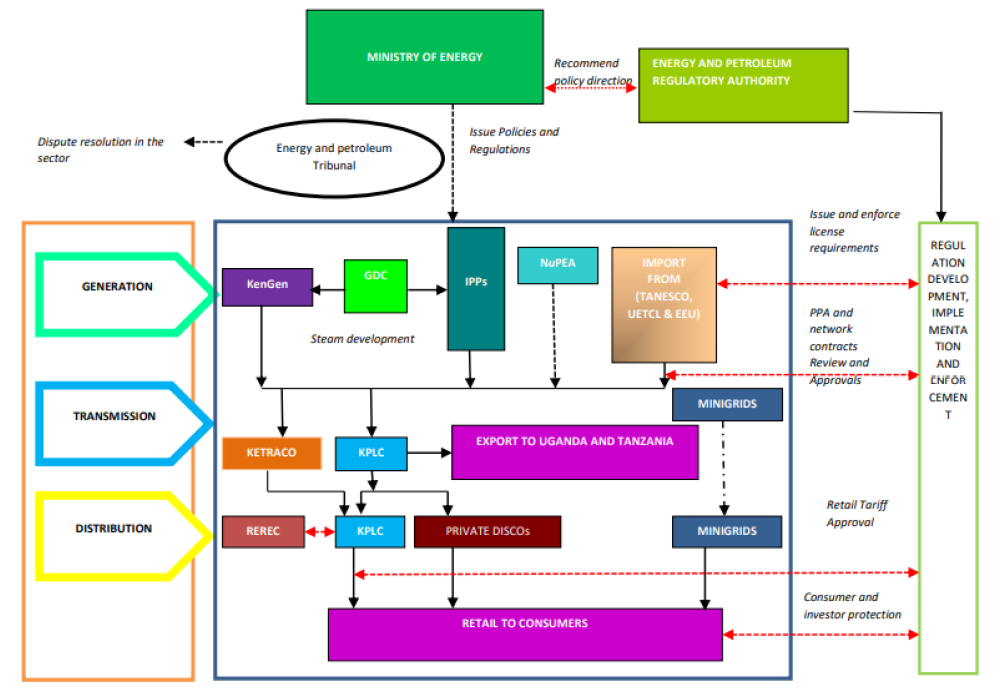OVERVIEW OF THE KENYAN POWER SECTOR
OVERVIEW OF THE KENYAN POWER SECTOR
The Kenyan power sector has gone through significant reforms from the late 1990s. These include review of the Electric Power Act 1997, Sessional Paper no. 4 of 2004, and enactment of the Energy Act 2006 which was recently succeeded by the Energy Act 2019. The new Act has introduced significant changes to the mandate of the various sector institutions to align them to the requirements and provisions of the Constitution of Kenya 2010. The sector has also facilitated considerable expansion in electricity generation, transmission, distribution and access in the country particularly in recent years. Institutional Sector Structure
After the enactment of a new Energy Act in March 2019, the institutional structure of the power sector was reorganized as shown in Figure 1.

a) The Ministry of Energy (MOE) is responsible for policy formulation and monitoring of policy implementation to enable an environment conducive for efficient operation and growth of the sector. It sets the strategic direction for the growth of the sector and provides a long term vision for all sector players.
b) The Energy and Petroleum Regulatory Authority (EPRA) is responsible for economic and technical regulation of the energy sector. Functions include Licensing of power sector facilities and technicians, Energy audit, tariff setting and sector oversight, regulations development and implementation including compliance and enforcement among others.
c) Energy & Petroleum Tribunal is an independent legal entity whose main purpose is hearing and determining disputes and appeals in accordance with the Constitution of Kenya 2010, Energy Act 2019 and any other relevant law.
d) Rural Electrification and Renewable Energy Corporation (REREC) is mandated by Energy Act 2019 to be the lead agency for development of renewable energy resources other than geothermal and large hydropower, in addition to its previous mandate of rural electrification.
e) The Kenya Electricity Generating Company (KenGen) is the main power generation entity in the country. It is also a repository of significant technical expertise in geothermal technology development.
f) Kenya Electricity Transmission Company (KETRACO) has the mandate to plan, design, construct, own, operate and maintain new high voltage (132kV and above) electricity transmission lines that will form the backbone of the National Transmission Grid & regional inter-connections. It is expected that this will also facilitate evolution of an open-access system in the country.
g) Nuclear Power and Energy Agency (NuPEA) is the nuclear energy programme implementing organization responsible for promoting the development of nuclear electricity generation in Kenya and carrying out research, development and dissemination activities of energy related 13 research findings. It is also expected to facilitate and coordinate capacity building activities in the energy sector.
h) The Kenya Power and Lighting Company (KPLC) is the system operator and the main off-taker in the power market buying bulk power from all power generators on the basis of negotiated Power Purchase Agreements (PPAs) for onward supply to consumers. It also owns and operates part of the existing transmission infrastructure and most of the interconnected distribution network.
i) Geothermal Development Company (GDC) is a fully owned Government Special Purpose Vehicle (SPV) undertaking surface exploration of geothermal fields, exploratory, appraisal and production drilling and managing proven steam fields. It also enters into steam sales agreements with investors in the power sector.
j) Independent Power Producers (IPPs) are private investors in the power sector involved in generation either on a large scale or for the development of renewable energy under the Feed-in-Tariff Policy.
k) Mini-grids are a set of electricity generators and energy storage systems interconnected to a distribution network that supplies electricity to a localized group of customers not covered by the interconnected national power grid as approved by EPRA.
I) Solar home systems companies supply the solar home systems for households far away from the grid and will play a significant role in ensuring universal access to electrification.
